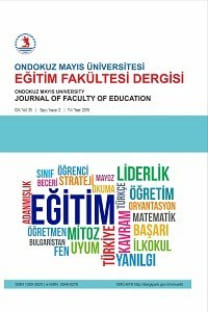Çevrimiçi Güvenlik ve Risk ile İlgili Eğitime Yönelik Geliştirilmiş Bir Çevrimiçi Ortamın Ortaokul Öğrencilerinin Bilgi Düzeyine Etkileri
Çevrimiçi güvenlik, internet güvenliği, bilgi güvenliği, siber güvenlik, çevrimiçi öğrenme, uzaktan eğitim
The Effects of an Online Environment Developed for Online Safety and Risk Education on the Knowledge Levels of Secondary School Students
online safety, internet safety, information safety, cyber safety, online learning, distance education,
___
- Ahn, J., Bivona, L. K., & Discala, J. (2011). Social media access in K12 schools: Intractable policy controversies in an evolving world. Proceedings of the American Society for Information Science and Technology, 48(1), 1-10.
- Boyd, D., & Hargittai, E. (2013). Connected and concerned: Variation in parents' online safety concerns. Policy & Internet, 5(3), 245-269.
- Bozkurt, A. (2020). Koronavirüs (Covid-19) pandemi süreci ve pandemi sonrası dünyada eğitime yönelik değerlendirmeler: Yeni normal ve yeni eğitim paradigması. Açıköğretim Uygulamaları ve Araştırmaları Dergisi, 6(3), 112-142.
- Çelen, F. K., Çelik, A. ve Seferoğlu, S. S. (2011). Çocukların İnternet kullanımları ve onları bekleyen çevrim-içi riskler. XIII. Akademik Bilişim Konferansı (AB11) Bildirileri, 645-652. İnönü Üniversitesi, Malatya. [Çevrimiçi: http://ab.org.tr/ab11/kitap/celen_celik_Riskler_AB11.pdf, Erişim Tarihi: 15.02.2021]
- Cresswell, J. W. (2017). Araştırma deseni nitel, nicel ve karma yöntem yaklaşımları (4. Baskıdan çeviri, S. B. Demir). Ankara: Eğiten Kitap.
- Eren, S., & Erdem, M. (2013). The examination of online kids’ sites with the purpose of raising kids’ self-protection awareness. Procedia-Social and Behavioral Sciences, 83, 611-614.
- Hartikainen, H., Livari, N., & Kinnula, M. (2019). Children’s design recommendations for online safety education. International Journal of Child-Computer Interaction, 22, 100-146.
- Hasebrink, U., Görzig, A., Haddon, L., Kalmus, V., & Livingstone, S. (2011). Patterns of risk and safety online. In-depth analyses from the EU Kids Online survey of 9-16 year olds and their parents in 25 countries. LSE, London: EU Kids Online.
- Kearney, W. D., & Kruger, H. A. (2016). Can perceptual differences account for enigmatic information security behaviour in an organisation? Computers & Security, 61, 46-58.
- Livingstone, S., Haddon, L., Görzig, A., & Ólafsson, K. (2011). Technical report and user guide: The 2010 EU Kids Online Survey. LSE, London: EU Kids Online.
- Mıhçı, P., & Kılıç-Çakmak, E. (2017). Öğrenci siber sağlık ölçekleri geliştirme çalışması. Gazi Üniversitesi Gazi Eğitim Fakültesi Dergisi, 37(2), 457-491.
- Moore, J. L., Dickson-Deane, C., & Galyen, K. (2011). e-Learning, online learning, and distance learning environments: Are they the same? The Internet and Higher Education, 14(2), 129-135.
- Ólafsson, K., Livingstone, S., & Haddon,L. (2013). Children’s use of online technologies in Europe: A review of the European evidence base. EU Kids Online. London, UK.
- Padlipsky, S. (2018). Using offline activities to enhance online cybersecurity education. Yayımlanmamış yüksek lisans tezi. California Polytechnic State University, California.
- Safa, N. S., Von Solms, R., & Furnell, S. (2016). Information security policy compliance model in organizations. Computers & Security, 56, 70-82. Sağıroğlu, Ş., & Alkan, M. (2018). Siber güvenlik ve savunma farkındalık ve caydırıcılık. BGD Siber Güvenlik ve Savunma Kitap Serisi. s. 26. Grafiker Yayınları. Ankara.
- Shillair, R., Cotten, S. R., Tsai, H. Y. S., Alhabash, S., LaRose, R., & Rifon, N. J. (2015). Online safety begins with you and me: Convincing Internet users to protect themselves. Computers in Human Behavior, 48, 199-207.
- Smahel, D., Machackova, H., Mascheroni, G., Dedkova, L., Staksrud, E., Ólafsson, K., Livingstone, S., & Hasebrink, U. (2020). EU Kids Online 2020: Survey results from 19 countries. EU Kids Online. London School of Economics and Political Science, London, UK.
- Tüzün, H., Bilgiç, H. G., Kalaycı, E., Çınar, M., Akıncı, A., Denizer, Y., & Yüksel, Y. (2011). Yerleşik bir dersin web tabanlı uzaktan eğitim için yeniden tasarımı. Demirci, B.B., Telli-Yamamoto, G. & Demiray, U., Türkiye'de e-öğrenme: Gelişmeler ve uygulamalar II (ss.175-199). Anadolu Üniversitesi Yayınları: Eskişehir.
- Zhao, Y. (2020). COVID-19 as a catalyst for educational change. Prospects, 49(1), 29-33.
- ISSN: 1300-302X
- Yayın Aralığı: Yılda 2 Sayı
- Başlangıç: 1986
- Yayıncı: Ondokuz Mayıs Üniversitesi Eğitim Fakültesi
Tayfun ARAR, Gülşen YURDAKUL, Melahat ÖNEREN
Türkiye'de Argümantasyon İle İlgili Yapılan Lisansüstü Tezlerin İncelenmesi
Zeki APAYDIN, Ayça CİRİT GÜL, Elif Omca ÇOBANOĞLU
Türkiye'de Argümantasyon İle İlgili Yapılan Lisansüstü Tezlerin İncelenmesi
Zeki APAYDIN, Ayça CİRİT GÜL, Elif Omca ÇOBANOĞLU
Fen Bilimleri Öğretmenlerinin Bilimin Doğası ve Bilim Tarihine Yönelik Görüşleri
Hakan Şevki AYVACI, Bahar MURADOĞLU
Pandemi Döneminde Üniversite Öğrencilerinin Fiziksel Aktiviteye Katılım Motivasyonunun İncelenmesi
Levent CEYLAN, Mehmet ÇEBİ, Murat ELİÖZ, Bade YAMAK
Bilgisayar ve Öğretim Teknolojileri Eğitimi Bölümü Öğrencilerinin Matematiğe Bakış Açıları
Fatma GÖLPEK SARI, Süleyman Sadi SEFEROĞLU
Özel Eğitim Okullarında Görev Yapan Rehber Öğretmenlerin Deneyimlerinin Belirlenmesi
TÜRKÇEDE ÇATI KAVRAMI, YÖNETME VE BAĞLAMA KURAMINA GÖRE ÇATI ÖĞRETİMİ
